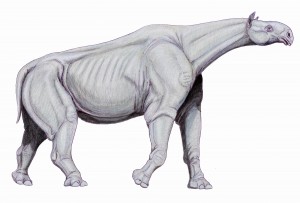Indricotherium
Indricotherium was the largest known land mammal, even though it was much smaller than its reptile contemporaries. It lived 20-35 million years ago in Central Asia – territories ranging from what is now Caucasia to Mongolia and China. The first Indricotherium fossils were discovered in 1913 by the famous Russian palanteologist Borisyak.
The size of this collossal animal reached 9,2 m in length and up to 5,4 metres in height, with a total body mass of 20-30 tons. Being the largest mammal of all times, Indricotherium was three times taller than a human. Its body was massive and rather plump, with a rather large head, and very muscular legs. Studies of the fossils show that this mammal was a herbivore that ate vegetation that grew high in the trees.
Having a rather short neck, compared to the long forelegs, it is clear that Indricotherium couldn’t eat ground level vegetation, but this body structure was suited for picking off leaves and branches as high as 8 metres above ground level, which is higher than any other mammal could reach. The animal’s molars were similar to those of the modern rhino, which means that the Indricotherium might have also had strong lips that could pick off leaves and branches, just like the rhino.
Due to the fact that only a few, and often incomplete Indricotherium fossils have been found, everything about their lifestyle and mating habits is purely speculation. Being somewhat similar to modern rhinos, some thoughts about the reproduction of these massive animals can be concluded. Gestation period of large mammals is proportional to their size – for rhinos it’s 15-16 months, for elephants – almost 2 years, and both of them give birth to only one baby. Therefore it is most likely that Indricotherium also had at least a two year long pregnancy and gave birth to only one young.
The common myth about mammoths being the largest mammals to have ever stepped foot on Earth is wrong, as they weighed on maximum half of what Indricotherium did. The African Elephant, which is the largest land mammal currently on this planet, weighs as little as one sixth of what Indricotherium did.
Although Indricotherium was a relative of modern rhinos, they didn’t have horns. Although rhino horns themselves are organic, and therefore wouldn’t preserve in fossils, there is a thing that can be seen on ancient animal skeletons – the base of the horn is strengthened by a bone growth. This bone structure can even be observed on the fossils of prehistoric rhinos, but skeletons of Indricotherium showed no signs of these animals having a horn.





I wouldn’t give to ride on top of an Indricotherium. C: